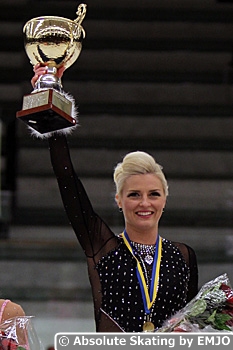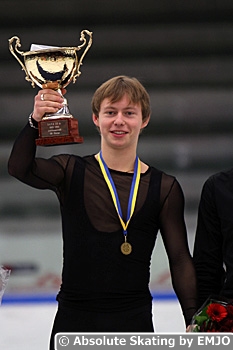The state of figure skating in Sweden, part 1
April 3, 2012
By Magdalena Osborne
Photos © Eva Maria Jangbro (EMJO)
About 100 years ago Sweden was a prominent country in skating. Between 1910–1912 three Swedish men claimed the gold at the European Championships: Ulrich Salchow, Per Thorén and Gösta Sandahl. Salchow won Europeans no less than nine times, but after his last win in 1913, it took decades for Sweden to gain back some of its former reputation. There have been no Swedish medals at Europeans since, not in men’s or any other discipline, but there are several skaters who have placed in the top 10 and also done well at the World Championships and even at the Olympics.
In this series weÂ’ll take a look at some of the people and events that make a difference in putting Sweden on the international skating map.
Swedish Nationals 2011/2012
A good way to get an idea of the state of a sport is to attend Nationals. The number of athletes, the areas they come from and the quality of their performances speak volumes about the sport and the forces behind it. This season was no different.
It was a surprise, but a good one, that the Swedish Nationals were held in Malmö for the second year in a row. The Malmö Ice rink may be old and run down, but it’s comfortable and the hallways offer plenty of space for sponsors and commerce. I could have bought new boots and blades as well as a gorgeous dress to skate in, along with matching jewelry and hairpins. Too bad I don’t skate.
 Walking into the rink one had to pass the information desk. Ann-ChristinĂ© Karlsson, the Malmö club president, was always smiling while selling tickets and programs, handing out media passes and answering questions. After having hosted the competition last year she was good and ready for a break, but here she was doing it again.
Walking into the rink one had to pass the information desk. Ann-Christiné Karlsson, the Malmö club president, was always smiling while selling tickets and programs, handing out media passes and answering questions. After having hosted the competition last year she was good and ready for a break, but here she was doing it again.
“Well, yes. Per Adler (the general Secretary of the Swedish Figure Skating Association) called in May and said that no other club had the time or means to organize Nationals; could we do it again? I hesitated at first, but asked my colleagues. They took the request as a compliment; the federation trusted us and thought we did a good job last time. So we made arrangements with the city and got busy! I’ve had wonderful people to help me and there were 82 volunteers! We like arranging larger events and we’re getting quite good at it…”
No kidding. This was as professionally organized as any competition IÂ’ve been to.
Ann-Christiné continued: “Of course it’s been a lot of work. We had to get everything set up on Tuesday, official practices started on Wednesday and the competition itself began on Thursday. It was hard for the volunteers since they work and go to school.”
Many of the volunteers were skaters and parents, who in spite of school and work managed to make everything run like clockwork. Monica Svensson was also stationed at the information desk. Her daughter Nicole competed in Junior Ladies.
Monica: “Without the parents there would be no organizing competitions. When we were asked we were flattered and of course we wanted to do it again, and even better this time! After last year’s Nationals we evaluated the event and our work, pinpointed what we did well and what could have been better. And this time we had even more volunteers. I’ve taken several vacation days to be able to help out.”
This is the type of dedication needed to bring the sport forward. Visitors were comfortable and could buy hot and cold snacks at decent prices. The press people were treated like royalty in the warm and quiet press room. It quickly became a home base and was great for interviews. The fact that there were always hot beverages, cookies or sandwiches there didnÂ’t make it any worse. Thank you to the very thoughtful people who kept us so comfortable!
Like last year, a live feed was provided through the Malmö club website. It could be watched in the halls, but also at home for those unable to attend.
 Senior ladies
Senior ladies
Viktoria Helgesson is becoming a household name. Before and after Nationals she was interviewed on TV and in papers numerous times. This season has been quite successful for her. At Nationals she was expected to win and she delivered, winning both the short and the free programs. Viktoria is a delight to watch as there is grace as well as technical skills in every move. And this season she has proved that even her competitive programs can be outside her usually so classical and beautiful box. She can also do edgier programs – and she can do so convincingly. She placed a fantastic fifth at Europeans two month ago and 11th at Worlds in Nice, where she landed a triple-triple combination in the short program. The only thing keeping her from the leading ladies is to make that combination consistent, along with the triple Lutz.
Joshi Helgesson was runner up and 15 points behind her older sister. She usually nails her Lutz and puts in in her programs. JoshiÂ’s style has always been faster and more fun than ViktoriaÂ’s, but she lacks some of her sisterÂ’s composure and elegance. Joshi also competed at Europeans and placed 10th, and at the recent Junior Worlds she finished 9th. Both sisters represent the Tibro Club. They are on their way up and there is no telling how far they will go.
But there is more. The bronze medalist at Nationals was Linnea Mellgren from the Enköping Club. She is the one with the triple toe-triple toe so clean it earns her extra GOE. At Nationals she totally sold her Black Swan short program, and performed an impressive part of her circular step sequence on one foot.
The Olssons should not be forgotten. Isabelle finished just off the podium and older sister Angelica in sixth place. Both are inspiring to watch; they are petite girls but with huge skating.
S enior men
enior men
With Kristoffer Berntsson no longer competing and Adrian Schultheiss out with injury, Alexander Sasha Majorov absolutely owned Nationals, crushing all competition. His Austin Powers short program was a show in itself with SashaÂ’s wonderful sense of entertainment. He opened with a beautiful triple Axel and an equally beautiful triple Lutz-triple toe combination. Sasha gains experience and confidence every season and his skating skills and showmanship increase as well. He has speed like few others and his footwork is to die for. ItÂ’s no easy task to skate to RavelÂ’s Bolero, but he was ready to take it on for his free program as his mother Irina explained in this interview earlier this season:
 Sasha attempted the only quad in the competition. He earned a total of 218.77 points for his programs and won by 76 points over silver medalist Mathias Andersson from the skating club in Lerum. Mathias won the junior national title last year but is now a senior. I liked his Lucky Luke short program and playful costume. He put on a real show sleeping on his horse, getting shot etc. In the kiss and cry he wore a cowboy hat to complete his image. The Gettisburg free program gave a more serious impression, and showing versatility is important.
Sasha attempted the only quad in the competition. He earned a total of 218.77 points for his programs and won by 76 points over silver medalist Mathias Andersson from the skating club in Lerum. Mathias won the junior national title last year but is now a senior. I liked his Lucky Luke short program and playful costume. He put on a real show sleeping on his horse, getting shot etc. In the kiss and cry he wore a cowboy hat to complete his image. The Gettisburg free program gave a more serious impression, and showing versatility is important.
Michael and Daniel Neuman from Malmö finished third and fourth. Being locals the audience loved everything they did. Both of these boys are very talented but need to step up their jumping game to include flip, Lutz and triple Axel to become major contenders.
Senior pairs
Last year I was happy and amazed Sweden had a senior pair again. Well, this time around there were two! Ronja Roll/ Gustav Forsgren from Jönköping were already there, now joined by l ast year’s junior champions, Michéle and Richard Lundberg from the Tyringe club. Watching both pairs and the progress they’ve made since last year was one of the competition high points. Ronja and Gustav managed well in their free program and pulled off a nice double loop throw along with some decent lifts. But the gold went to the Lundbergs who impressed with a great step sequence and a side by side double Salchow in their circus short program and level 4 spins in the free skate. The lifts looked pretty solid, and after Nationals this pair was added to the Swedish team for Europeans. Unfortunately they couldn’t go as Michéle suffered a foot injury, and also missed Junior Worlds. Next year, guys!
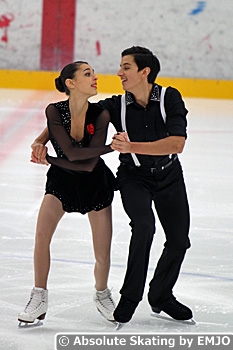

 Junior pair
Junior pair
There is still a junior pair. Alexander Backlund from the Gävle club competed with Vera Björklund as Novices last year. Now he has a new partner in Elsa Widén. They had only skated together 7 weeks before Nationals and it was brave of them to even enter. Elsa had trouble with her luggage not making it to Malmö and had to buy a dress at the competition. Luckily there were plenty of dresses for sale and this pair looked very cute. Their skating is of course still juniorish, but given time they will progress. Keep going!
Junior ladies
The juniors are always interesting to watch since they are the future. The ladies are always a large group and several of the girls are very good! This was one of the most exciting  events in the competition. Last yearÂ’s winner, Rebecka Emanuelsson from the Ă„lta club, had to settle for silver this time. After the short program she was only in fourth place, but the top was very tight. The free program to Turandot w as full speed ahead. I especially liked the Sasha Cohen trademark spiral. The winner was Elin Hallberg from Uddevalla. She opened her free skate Somewhere from West Side Story with the slightly odd double Lutz-triple toe combination. Her spins were all level 4. The choreography was excellent and her program highly enjoyable. Well done!
events in the competition. Last yearÂ’s winner, Rebecka Emanuelsson from the Ă„lta club, had to settle for silver this time. After the short program she was only in fourth place, but the top was very tight. The free program to Turandot w as full speed ahead. I especially liked the Sasha Cohen trademark spiral. The winner was Elin Hallberg from Uddevalla. She opened her free skate Somewhere from West Side Story with the slightly odd double Lutz-triple toe combination. Her spins were all level 4. The choreography was excellent and her program highly enjoyable. Well done!
The bronze medal went to Josefin Taljegård from Göteborg, again. Josefin lives her programs with her body and face, and always includes fun moves – a real show girl!
An update on Malmö’s Nicole Svensson. Yes, she is the daughter of Monica who greeted visitors at the information desk. Nicole finished 8th overall in this competition, up from 14th last year. She is the definition of grace on the ice, but had no triples in her program. Once she gets those she will advance quickly.
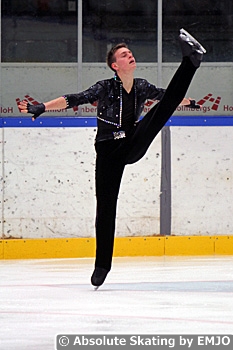 Junior men
Junior men
Where there were 24 junior ladies, there were only 9 men. The winner was Nicky Obreykov from Sollentuna, who won as a Novice last year. This little man is light as a feather on the ice, but boy, can he jump! His short program was to Winter by Bond, and it was hard not to think of Alexei Yagudin’s unforgettable performance at the Salt Lake City Olympics 10 years ago. Finishing only three points behind Nicky was local talent Marcus Björk. He has grown a lot in a year, and not just taller; a triple Axel is in the making! Marcus is on the National team and got bronze at the Nordics. He also just competed at Junior Worlds where he placed 24th.
Remember this name: Josef Oscarsson-Eriksson. He walked away with the bronze but the amazing part is heÂ’s only been skating three years! He was in gymnastics before that though and it really showed in his programs. Josef doesnÂ’t have all the triples but he made up for it in entertainment value, costume and great choreography. If he ever decides not to compete heÂ’ll have a great future in show skating.
 Novice girls
Novice girls
This was pretty much about one girl; Myrtel Saldéen-Olofsson from Malmö. Last year she got bronze, this time she grabbed the gold and rightfully so. She is starting some triples, but most of all she has speed and grace, which showed in her free program to Nightingale by Yanni. Myrtel competed in the Youth Olympics in Austria in January and placed 14th.
Victoria Englund from the Tyresö skating club got silver after a fast and pretty much clean Don Quixote free skate. Klara Fröberg from Sollentuna upped from 5th place after the short program, to bronze.
Novice boys
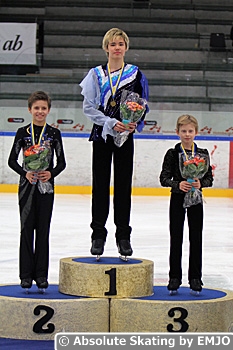 There were five guys competing and it was quite impressive to see what they were capable of. They have a way to go with the jumps, but they are all learning how to entertain. John Hallman from the Landvetter club won, with Illya Solomin, Solna, as runner up. The bronze went to Alexander Majorov’s little brother Nikolaj. The Majorov family sure had a busy week in Malmö with both parents coaching and both sons competing and medaling.
There were five guys competing and it was quite impressive to see what they were capable of. They have a way to go with the jumps, but they are all learning how to entertain. John Hallman from the Landvetter club won, with Illya Solomin, Solna, as runner up. The bronze went to Alexander Majorov’s little brother Nikolaj. The Majorov family sure had a busy week in Malmö with both parents coaching and both sons competing and medaling.
Debs girls
There were 12 girls competing and the total score ranged from 51.54 up to 89.72 for gold medalist Cornelia Nilsson, who made her Vallentuna club proud. This girl has a double Axel and put on a convincing performance to Finding Neverland in the free skate. There was good speed in the camel spin and a fun hydroblading move.
Runner up Jennie Ericsson, Tibro, returned to Neverland in her free program. She had good speed and a pretty spiral.
The bronze medal went to Elsa Spenninge, Lund.
The competition wrapped up, as usual, with the medal ceremonies. It had been four days of excitement and great skating and now it was time to go home and celebrate Christmas. Nationals is not a big competition as far as media coverage or audience attendance is concerned. But it is big in showing how much potential lies in the many clubs throughout the country; from north to south. Coaches and choreographers are doing a fantastic job preparing their student for competitions, and the Swedish Figure Skating Association is doing all they can to give the skaters more opportunity to gain competition experience and thus be more prepared for the big international events. The reputation of Swedish figure skating has grown a lot in the last few years, and high class performances are now expected from the skaters representing the yellow and blue flag. I was not disappointed.
